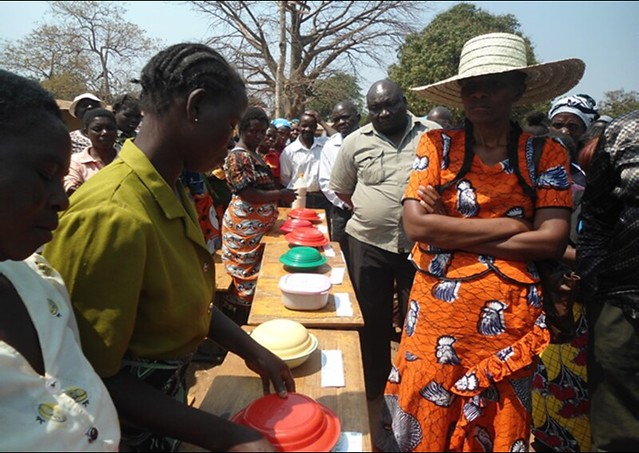Africa RISING cooking up a legume delight in Malawi

Malnutrition and food insecurity remain perennial challenges for families living in rural Malawi. According to estimates by the United Nations Children’s Fund (UNICEF), more than two in five children under 5 years (46 percent) are malnourished. Despite this grim scenario, the Africa Research in Sustainable Intensification for the Next Generation (Africa RISING) project team is succeeding in combating malnutrition and food insecurity within two rural districts in Malawi–Ntcheu and Dedza–where they have reignited interest among farmers in intensifying production of five grain legumes; groundnut, cowpea, common beans, pigeon pea and soya bean.
Through a ‘learning by doing’ research approach, the research team has succeeded in changing the perception and attitudes of the farmers towards grain legumes by carrying out a series of nutrition workshops within the two districts.
Following harvest of the 2013/14 crop in May, the team, together with partners from Lilongwe University of Agriculture and Natural Resources (LUANAR) and the Malawi Agricultural Extension Services Department conducted a series of nutrition workshops in each of the four action sites (Kandeu and Nsipe in Ntcheu District, and Linthipe and Golomoti in Dedza District) where research has been carried out over the past three years. During the workshops, farmers were trained on the best cooking techniques for preparing grain legume meals for their families out of elements like soya bean pods which can be poisonous if not well prepared. The farmers were also trained in the application of simple innovations that involve ‘wet’ heat cooking which easily destroys the anti-nutritional elements in soya bean pods allowing families to enjoy rich protein diets.

The highly interactive workshops usually begin by dividing farmers into groups composed of both men and women. Next, they are trained on how to prepare simple, tasty and nutritious meals from different grain legumes. The farmers are then given the opportunity to cook the meals. Once the meals are ready, they then open ‘shops’ in a mock food market where other participants come and taste what each cook has prepared.
So far, the nutrition workshops have attracted the attention of hundreds of farmers and will likely be a significant pull factor for increased local utilization of grain legumes in the two districts considering that nearly all the farmers enjoyed the meals. Through this project and by using the nutrition workshops, the project team has succeeded in improving human nutrition and restoring soil fertility using grain legume farming.
The workshops have also been credited with creating major social changes within the local communities. For example, the local chief (Nkosi) of the Ngoni community praised the workshop saying that ‘Africa RISING has brought some magic here – cakes from our own crops have substituted beer today!’
Written by Regis Chikowo (Plant, Soil & Microbial Sciences Department – Michigan State University)





Latest Comments